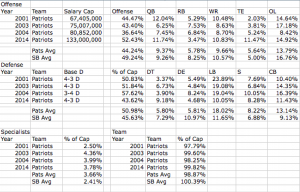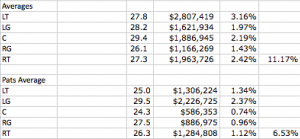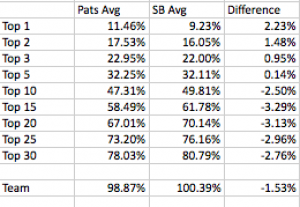As a reminder, as always, much I discuss here is based on theories I have and especially regarding this, I haven’t done all the research, so this is basically a first draft of some of the stuff I’m writing for Caponomics (information for the e-mail list at the end of this article). I will complete the research required to ensure this is 100% accurate for the book, but what’s written here was my initial reaction on the figure below. If anyone is more of an expert on the Pats in the early 2000s, please comment below and/or feel free to e-mail me at Caponomics@gmail.com.
Figure 1: Patriots Super Bowl Positional Averages
(As always, click on the pictures to enlarge them.)
- Belichick switched between 4-3 and 3-4 defense throughout his time, especially the 2001-03 seasons before switching to the 3-4 as his base defense in 2004. This just adds to the amount of confusion that he throws at opposing offenses. I also have a working theory that they go after very intelligent defensive players to run their schemes and don’t have to necessarily go after the most expensive athletes on the market. In 2014, they ran a base 4-3, but their defense was so multiple that PFF ranks their front seven as a 3-4 AND they consistently ran a 4-2-5 as well with Kyle Arrington typically in the starting lineup at a fifth defensive back position.
- The 2003 defensive end cap number was low because Richard Seymour was listed as a defensive tackle this season, in 2004, the DE cap number went up as Seymour was listed there. He switched between both positions throughout his time with the Patriots. They got 23 sacks out of Mike Vrabel, Seymour and Willie McGinest in 2003.
- They spend more money on linebackers because they need more, versatile players for their dynamic defenses.
- Tight end was typically below the Super Bowl average because they went after blocking types who weren’t very expensive because they were block first guys who didn’t catch a lot of balls. Using tight ends who are essentially another offensive lineman is part of how they run the ball so well with less money spent on the position. Throughout Belichick’s run, he’s had top blocking tight ends and Gronk even falls into this category as he was one of the five best blocking tight ends according to PFF each of his first three season in the NFL before the injuries, which have probably had to do with some regression there.
- They were always on the big money spending on cornerbacks, even before the new wave of this. Their average for their four Super Bowl champs is 4.01% higher than the Super Bowl average and every single one of their teams was above the average.
- They’ve always spent a little more than the average on specialists because they always have a great kicker.
- Safety is a position where they’ve always spent more, but that’s largely due to Lawyer Milloy’s dead money deal in 2003-04.
- 2014 was the first time they spent more on offense than defense.
- They’ve always had at least one or two expensive linebackers, listed below are the linebackers who have been in their top 10 cap hits.
- 2001: Willie McGinest, Ted Johnson, Chris Slade, Tedy Bruschi
- 2003: Ted Johnson, Mike Vrabel
- 2004: Willie McGinest, Tedy Bruschi, Mike Vrabel
- 2014: Jerod Mayo
- Dont’a Hightower was their 20th cap hit; Jamie Collins was 30th
- In fact, considering that they’ve typically been more a base 4-3 team through these years, although they’ve played both, the fact that they have spent half of the Super Bowl average on their defensive ends, but 155% the average for linebackers leads me to believe there might be a strategy to look into here.
- A true testament to their coaching, especially offensive line coaches Dante Scarnecchia (2000-2013) and Dave DeGuglielmo (2014), is the fact that they’ve had a cheaper offensive line and cheaper offensive line starters than the average SB team. Belichick is so confident in DeGuglielmo and there’s such a trust that DeGuglielmo didn’t find out about the Mankins trade until Belichick announced it to the team. On top of that, Bryan Stork was injured to start the year. McDaniels helped overcome some of the line issues this year with more quick passes and the OL was a huge part of the champions.
Figure 2: Offensive Line Averages
- Here is how much less they spend than the average Super Bowl Team:
- LT: -1.82%
- LG: only position they spent more at, 0.40% more
- C: -1.45%
- RG: -0.47%
- RT: -1.3%
- The Pats have had a young, inexpensive center on every one of their Super Bowl teams and surrounded him with some more experienced guards. Investing only 0.74% of your cap in your center is extremely low for championship teams as you can see from the difference in the averages, I’ll dig deeper into this, but it seems like they save money by drafting a young center and just surround him with a stronger, more experienced line around him. When you think about it, your center needs to be a smart player, but does he need to be your best offensive lineman? There are many ways to overcome center’s inefficiencies like double teams, so maybe that’s what the Patriots are thinking. Above all else, you need a intelligent center who meshes well with the line, you don’t need a stud. Of course, Dan Koppen was their center from 2003 to 2010, so he was a bit more expensive later in his career.
- They seem to draft most of their starting linemen on these championship teams.
Figure 3: Patriots Top 30 Cap Hit Averages vs. Super Bowl Averages
- Part of what showed made me realize we were on to something looking at the top cap hits for these Super Bowl teams and using them as a barometer is that across the last 15 years, the Patriots have steadily been right around these numbers, never getting out of whack like teams like the 2014 Lions, Dolphins, and Buccaneers, to name a few. I haven’t completed my research on the 2007 Patriots, but their spending was right around these figures as well as positional figures. The fact that they got such value out of Brady, Moss, Stallworth and Welker that year was a huge X-factor in their undefeated regular season.
- Throughout Belichick’s time, he’s been able to find low-cost players near the end of their career who have accepted less expensive deals with the Patriots to try to win a Super Bowl. This has been a huge advantage for them as they have been able to get some great veteran leadership and solid play from guys who are on the hunt for a championship above all else.
I’ve gotta get up and out for a dinner, but I might expand on this list later, follow me @ZackMooreNFL and of course…
If you want to purchase The First Annual Caponomics: Understanding NFL Roster Building through Super Bowl Champion Salary Cap Analysis, please e-mail me at Caponomics@gmail.com, so that I can put you on our e-mail list for people interested in purchasing the book. Much of that analysis here is similar to what you’ll find in the book! If you join our e-mail list, I will send you the first chapter on the 2014 Lions and then the 2014 Patriots once it’s completed. I might even throw in a bonus Super Bowl champ in.
I’m currently in the process of getting some legal stuff handled for the book and then I can put the pre-order up on Amazon, otherwise, it would already be up there. Thanks for your support and feel free to send me any questions or ideas to that e-mail address.


